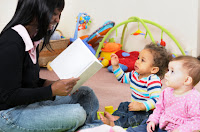(1) Why read aloud to children?
Reading aloud promotes language development and language enrichment. Book language is generally more complex than spoken language. It exposes children to more sophisticated vocabulary and more complex sentence structure.
"Before a child can learn to read, a child must have been read 1,000 books." ~ Mem Fox
At 4 books a day for 5 days a week this will be accomplished in less than 1 year.
 Research by Betty Hart and Todd Risley of the University of Kansas found that at the age of six, children from families who value education and where parents read to and with their children daily have a 20,000 word vocabulary, while their peers from families where reading is not encouraged know only about 3,000 words.
Research by Betty Hart and Todd Risley of the University of Kansas found that at the age of six, children from families who value education and where parents read to and with their children daily have a 20,000 word vocabulary, while their peers from families where reading is not encouraged know only about 3,000 words.Should I read the same story over and over?
Repetition helps children understand the form and structure of language and the story and enriches their ability to retell or act out the story in addition to adding the positive of participation.
Young children need to hear a word 9-14 times before they know it. (Betty Hart & Todd Risley)
Watching TV?
Increased time spent watching television during childhood and adolescence is associated with a lower level of educational attainment. Children who watch a great deal of television (more than 3 hours a day) have shorter attention spans, less creative thinking skills, and bad attitudes towards school.
Do not allow children younger than 3 years old to watch TV. ALL experts agree on this.
Is it OK for a child to ask questions or make comments?
Participation involves children in the story, helps them own the story, be better listeners, think about the story, remember the story, it helps hold their attention, and gradually helps lengthen their attention span. Plus, it is FUN!
 Is reading aloud to children important? YES!!
Is reading aloud to children important? YES!!"The single most important activity for building understanding and skills essential for reading success appears to be reading aloud to children. High quality book reading occurs when children feel emotionally secure and are active participants in reading." ~ Joint position statement of the IRA (International Reading Association) and NAEYC (National Association of the Education of Young Children)
"Reading is important. Books are important. Children’s fiction is the most important fiction of all." ~ Neil Gaiman (Excerpt from his acceptance speech as the winner of the 2009 Newbery Medal for The Graveyard Book.)
For the most part, the students embraced these concepts and discussed the ideas. Several of the boys were willing to read and offer their thoughts. They were genuinely interested. Unfortunately, several of the girls had just returned from court and their mood was a bit somber. But I stayed positive and hoped they would find value in the discussion.
(2) After discussing reading aloud to children, I read aloud to the students! I combined Christopher Myer's picture book, Black Cat, and the song, "Moments in Love", by The Art of Noise. (My sister, Kathy, gets credit for finding the music.) The words with the music create a wonderful rhythm. It's a little like rap. The students loved it. The boys were chanting along with the chorus and although the girls were still a bit bummed, some smiles began to sneak onto their faces. There may or may not have been a guard or two getting their groove on in the back of the room.
(3) The hour concluded with students creating their own Black Out poetry. The poem below was created by my most enthusiastic student. He was a willing reader, loudly chanted the refrain in Black Cat, and eagerly created his poem.

